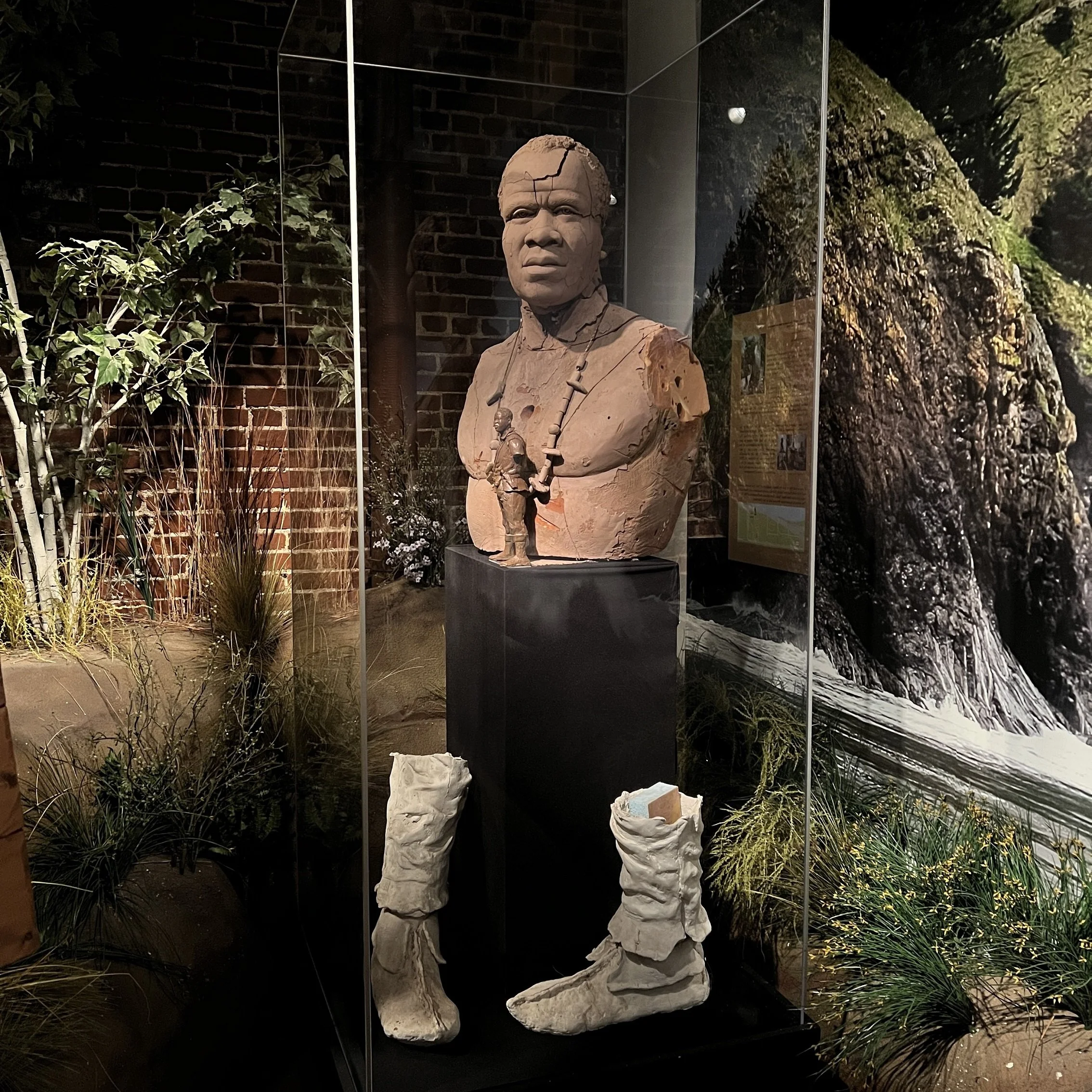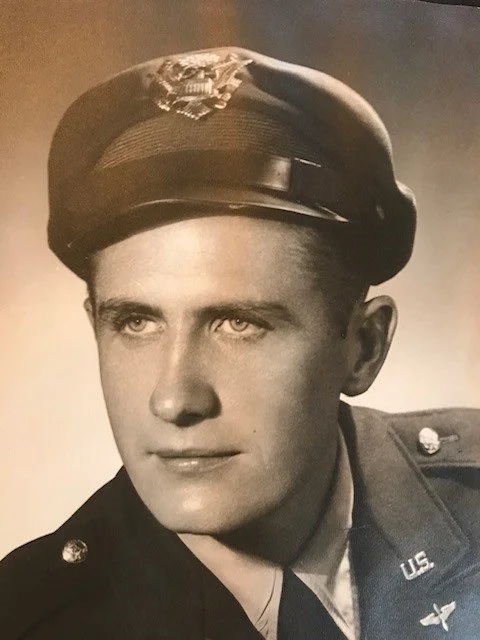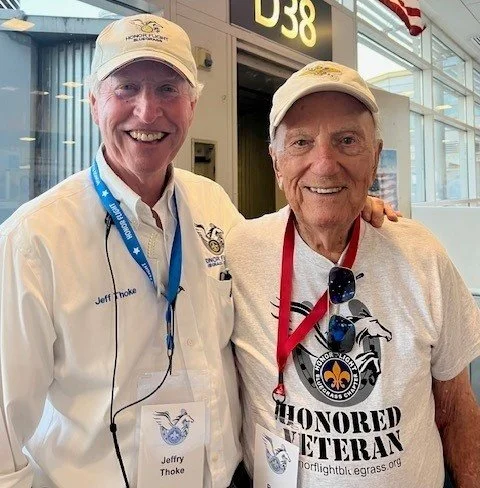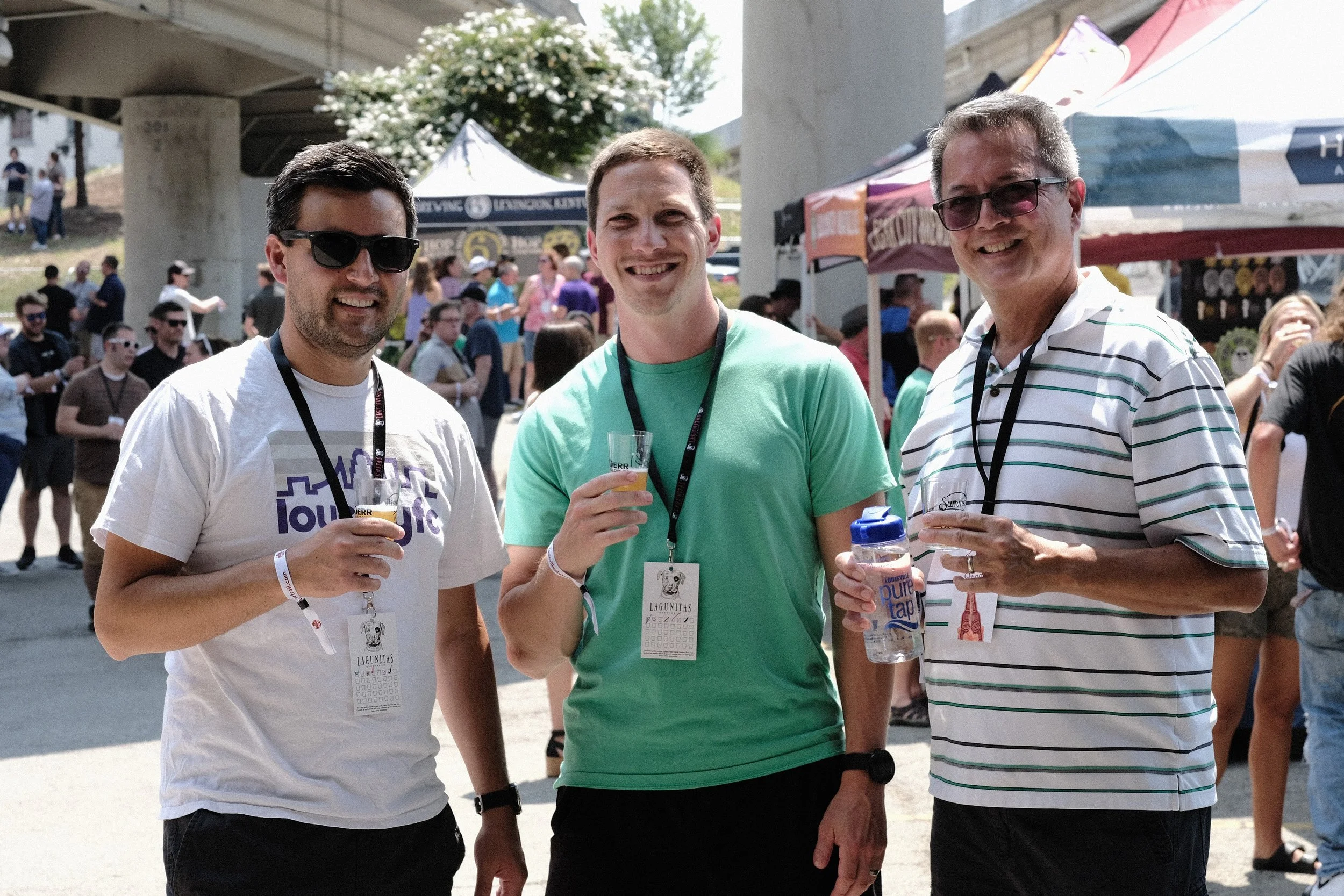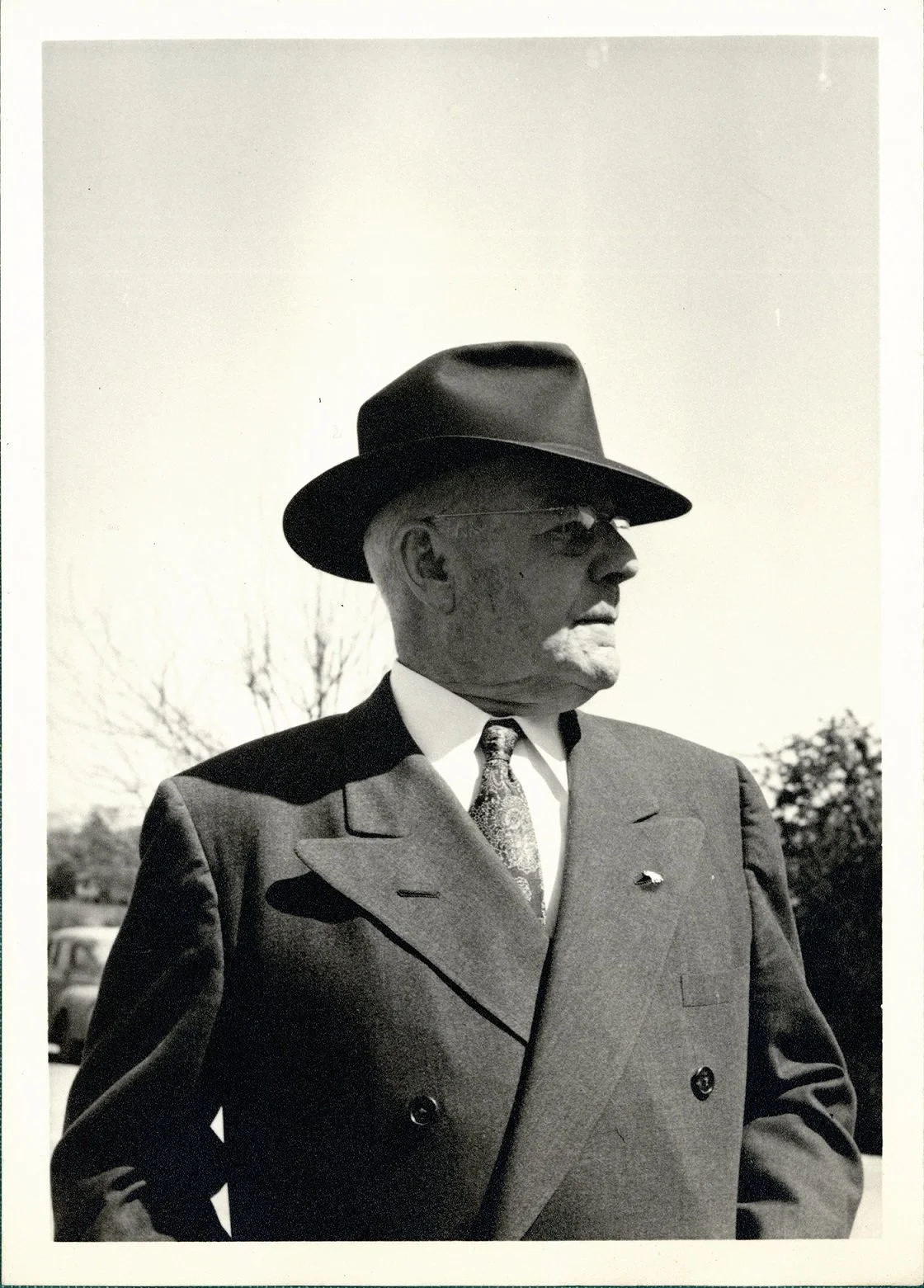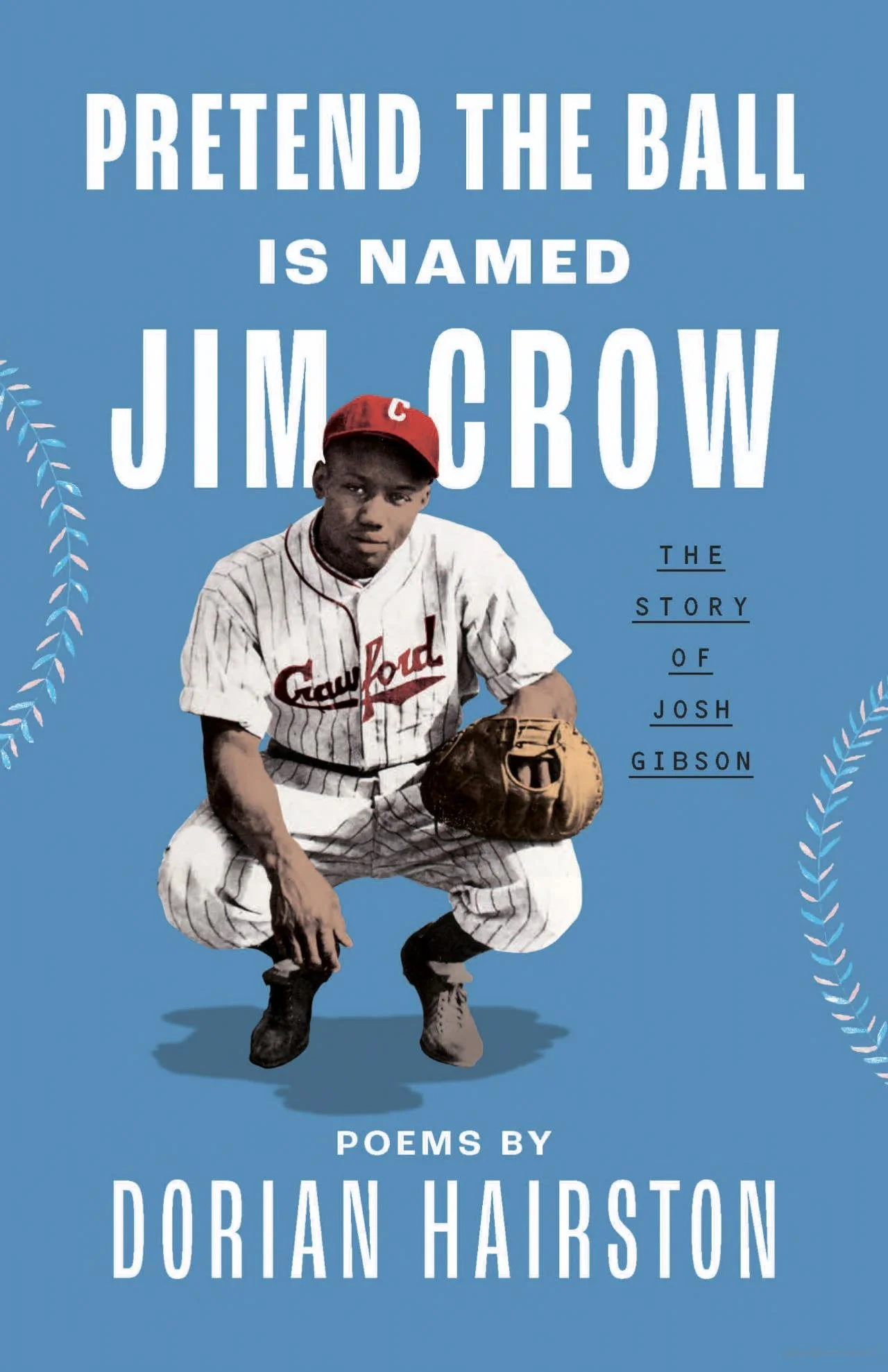Lewis & Clark Exhibition Updates, Free Cultural Pass Admission Sundays & Mondays, Butler County’s Navy CINCUS, and More
We continue to celebrate our 20th anniversary here at the Frazier and have just completed a refurbishment of our longest-running permanent exhibition, the Lewis and Clark Experience! Opening ten years ago and taking up half of the third floor, this temporary exhibition quickly became a guest favorite and shifted to become our first permanent feature at the Frazier. In 2018, the footprint was downsized to make room for additional gallery space. This time around, though, we have updated the space to make it more interactive and immersive.
As you enter, the first room is all about keelboats and preparing for the trip west. The first exciting update comes in the form of an animation inspired by drawings from the journals of Lewis and Clark created by our experience and digital media intern Olivia Duke. The next fun upgrade is to our “not so ferocious” bear cave with seating and books for kids to read with the bear in his home.
Waterfall in the Lewis and Clark Experience, May 31, 2024. Credit: Frazier History Museum.
York case in the Lewis and Clark Experience, May 31, 2024. Credit: Frazier History Museum.
The biggest change to the exhibition is in the back half. Along with all new graphics, we have majorly overhauled the fishing hole with new fish and a fun game to go along with it. Kids and adults alike will love the new waterfall! There’s also a new rowing machine so visitors can try their strength against the currents of the Snake River. You might even spot some bats hiding out in the cave!
As you approach the end of the expedition, we have a brand-new case all about York, an enslaved African American man who belonged to William Clark, who had accompanied Lewis and Clark on their trip. York was a valued member of the team and even had equal voting powers when the group was deciding whether to stay in the Pacific Northwest or return home before winter. The items are all casts for Ed Hamilton’s bronze York statue located on the Belvedere just four blocks away from the Frazier. Coming eye to eye with York in that space is truly powerful.
It has been exciting for not only our guests but staff to engage in the new space and see all the improvements that have been added!
In today’s Frazier Weekly, Mick Sullivan announces the return of our Cultural Pass program and Stephen Yates previews our Jim Beam program for Father’s Day. Jeff Thoke of Honor Flight Bluegrass shares his personal thoughts on D-Day, Tish Boyer talks preserving history, and Simon Meiners shares the Butler County story from our 120 exhibit. Plus, Leslie Anderson previews this year’s Summer Beer Fest at Frazier and Rachel Platt teases Duncan Hines Days in Bowling Green. Finally, Dorian Hairston and Tad Myre shed light on the integration of Negro Leagues stats into the MLB record.
Thank you for reading!
Nick Cook
Exhibit & Design Manager
Frazier History Museum
This Week in the Museum
Frazier Offering Free Cultural Pass Admission on Sundays and Mondays
One of the best things about summertime in Louisville is the Cultural Pass program that offers special programming or free admission to over fifty cultural sites around the city for students and an accompanying adult. Here at the Frazier, we are offering free Cultural Pass admission on Sundays and Mondays between June 1 and August 4.
A young visitor explores the Civil War gallery in the Frazier’s Commonwealth exhibition, May 2022. Credit: Mary Helen Nunn.
When you come with your pass, be sure to grab one of our Cultural Pass Cool Kentucky scavenger hunts and see what your family can spot around the museum. We’ve also got special offerings on Mondays, including public tours at 11 a.m. and 3 p.m., and well as a hands-on touch cart perfect for families every Monday at 1 p.m.
Anyone under the age of twenty-one can get their free Cultural Pass at any branch of the Louisville Free Public Library as well as libraries in many surrounding counties.
In next Monday’s edition of Frazier Weekly, I’ll have more on a new offering for Cultural Pass. Stay tuned!
Mick Sullivan
Curator of Guest Experience
Sippin’ with Stephen: Knob Creek Single Barrel with Beam Suntory’s Trey Harris
As the official starting point of the Kentucky Bourbon Trail®, the Frazier History Museum shares stories of the people, places, and producers of the Kentucky Bourbon industry. To learn more, visit our Kentucky Bourbon Trail® Welcome Center or tour our Spirit of Kentucky® exhibition.—Simon Meiners, Communications & Research Specialist
This week, the Sippin’ with Stephen crew takes the show on the road to the James B. Beam Distillery in scenic Clermont, Bullitt County, Kentucky. Our host, Beam Suntory sales and event coordinator Trey Harris, leads us on a brief tour of some of the distillery’s fantastic offerings, including the American Outpost, the Kitchen Table Restaurant, and finally a review of a Knob Creek Single Barrel product.
If you’re a fan of Beam, join us at the Frazier on Tuesday, June 11, for a Bourbon program titled Father’s Day with Fred and Freddie Noe from James B. Beam Distillery. Guests will get to taste the Knob Creek Barrel selection the Frazier chose along with a variety of other James B. Beam products. There will also be a signature cocktail, food pairings, and the opportunity to purchase a Knob Creek Frazier Barrel Selection bottle.
Grab a ticket for your dad, too—it’s the perfect Father’s Day gift!
Stephen Yates
Community & Corporate Sales Manager
On this Date: Invasion of Normandy, June 6, 1944
The most recent Honor Flight, which took place in Washington, DC, May 21, 2024. Two of the veterans pictured are WWII veterans. Credit: Jeff Thoke.
Jeff’s father Robert Thoke, undated. Credit: Jeff Thoke.
As Thursday marks the eightieth anniversary of D-Day, there’s one very special person I wanted to write about it for Frazier Weekly: Jeff Thoke, the chairman of the board of Honor Flight Bluegrass. That organization flies our heroes to Washington, DC, to visit their respective memorials. The most recent flight happened on May 21. Two WWII veterans were part of it. Jeff loves our veterans and serves Honor Flight in memory of his father, Robert, who was a WWII veteran. Sadly, many of those veterans are no longer with us, which is why we need to cherish the Greatest Generation while we still have them. You can join Jeff this Thursday at Bowman Field as WWII veterans are taken on a free flight aboard a B-25. The public is invited to salute them starting at 11 a.m. at the Old Terminal Building on Taylorsville Road.—Rachel Platt, VP of Mission
Eighty years ago, on June 6, 1944, what we now call D-Day, the largest naval, air, and land invasion in history took place in France against the occupied armies of Nazi Germany. By the end of the day, 156,000 Allied soldiers had landed on the beaches of Normandy. Despite the overall success, over 4,000 Allied troops had been killed by German soldiers. Within a few days, over 300,000 troops, thousands of vehicles, and over 100,000 tons of equipment would arrive. By August of 1944, northern France would be liberated. On May 8, 1945, Germany would surrender to the Allies.
From left, ninety-nine-year-old WWII veteran Lee Smith and Jeff Thoke. Credit: Jeff Thoke.
From left, Jeff Thoke and 101-year-old WWII veteran Paul Jones. Credit: Jeff Thoke.
It’s hard to believe it has been eighty years since this historic day occurred. Of the sixteen million men and women who took part in WWII, there are approximately only 100,000 WWII veterans left to tell us their stories. These are who we call the members of the Greatest Generation. In a few short years, all of them will be gone. Many of us have family members who were part of this generation. They may have been fathers—such as mine, who was a co-pilot on B-17s and B-29s. To others, they may have been grandfathers, grandmothers, or even great-grandfathers or great-grandmothers. But to all of us, these were truly special people. When America went to war on December 8, 1941, men and women from all over our country and from many different occupations stepped up to defend our country and to help defeat those leaders that had intended to rule the world. Over the course of four years, more than 400,000 soldiers would lose their lives liberating those that had been occupied by the Axis powers.
At Honor Flight Bluegrass, our mission is to fly America’s veterans from WWII, Korea, and Vietnam from the Bluegrass region to Washington, DC, to visit the war memorials dedicated to honor their service and sacrifice to our great country. With the eightieth anniversary of D-Day fast approaching, I ask at this time we honor those remaining WWII veterans who are still with us today. These veterans changed the course of history, all for the good of mankind. They went off to war, did what they had to do, came home, raised families, and did not say too much about their time in the service. They truly saved the world so we are able to enjoy the freedoms we have today. I often think about how different the world would be today had we not been successful on D-Day, not turned the Germans back during the Battle of the Bulge, or even lost WWII. We will never know.
While there is still time to do so, I ask if and when you see a WWII veteran, go up and thank them for their service. Time is of the essence as we lose about 130 WWII veterans every day here in the United States. An eighteen-year-old who signed up in 1945 is now ninety-seven years old. Within five years, most will be gone and will be part of our history. Although they may not want it or ask for it, our WWII veterans deserve the recognition for what they accomplished all those years ago. It is the least we can do for what they did for us.
Jeff Thoke
Honor Flight Bluegrass
Guest Contributor
Tish Boyer’s paternal grandfather William Warren Boyer, 1944. Credit: Tish Boyer.
Letter a woman named Ruth wrote to her mother, dated March 18, 1931. Credit: Frazier History Museum.
Thursday will mark eighty years since D-Day. While I never served in the military, I come from a long military tradition. My grandfather was a Naval pilot in World War II. My Dad served twenty-one years in the Navy and was in Vietnam. My mom also retired Navy. My older brother has been in the Army for nearly twenty-four years, including three separate tours to Iraq. And that doesn’t even begin to dive into the military service of nieces and nephews.
Some of the really great mementos from the second World War are the letters servicemen sent home to their loved ones. As a historical record, I really enjoy letters and don’t think you will find better firsthand accounts of a person’s life and experience. A lot of family members often save their letters, especially letters sent home during wartime. So today, instead of looking at a piece from our collection, I want to look at how you can preserve your family letters to pass on to the next generation.
The first thing to think about with any preservation project is the agents of deterioration that can cause the most damage to the material—in this case, paper and ink or pencil. When it comes to letters, there are three main agents of deterioration: light, temperature/humidity, and acidity. Light can cause the fading of inks, colors of paper, and can cause the paper fibers to become brittle. Temperature and high humidity—which we’re no strangers to here in Kentucky—can cause mildew and even mold on paper. But the biggest problem for paper is acidity. For example, letters stored in cardboard boxes can cause irreversible staining and discoloration. Also, letters that have had a newspaper clipping folded up in it for a long time will also show evidence of staining.
I think it is important to be able to read your family letters as previously discussed; it’s a great way to see how your family lived and what they thought. Most of us keep our letters folded in their original envelopes. And while it is great to have both pieces, it is best to keep them stored unfolded. The more you fold and unfold a letter, the more you increase the risk of tearing the paper. The paper will become particularly weaker at the creases of the fold. So, think about unfolding and storing flat. To make sure that you don’t lose the envelope, try taking acid-free paper and making a little “envelope” that you can wrap around the letter. Then clip them together with a Plastik clip, which won’t rust over time. But you can think of any type of clip that is not metal which won’t rust. Of course, we do not recommend any sort of stapling, which will cause tearing.
For storage, you can think of it in a few different ways. They can either be stored flat and stacked in an acid-free box; or, depending on how many or how much work you want to do, you can get acid-free files and put them in files before putting them in a box. I personally like organizing letters in a file by month and then year, or by recipient and year; but of course it should be what would make the most sense to you. When you are looking for materials, you may be able to find most of what you are looking for at a hobby shop such as Michaels or Hobby Lobby. Here in Louisville, there is a great art store called Artist & Craftsman Supply that may have some of the materials you will need. The key thing you want to look for is acid-free when looking at materials. A lot of plain white paper comes acid-free these days so just make sure to check.
Now that you have your letters carefully unfolded, laid out in a box, and ready for long-term preservation, you may ask yourself: Where should I keep the box? That is a great question. As discussed, here in Kentucky, we deal mostly with high temperatures and humidity so think about that place in your house that stays the most stable. This might be a closet on the main floor of your house like a hall closet and you might keep your box on the top shelf. I like to keep my letters at home in the top of my bedroom closet because that is the space which is most comfortable to me in my apartment. Try to avoid basements and attics. These areas tend to be either too damp or too dry. A really good way to think about it is if it is a comfortable temperature to you, it will be for your items.
Keep an eye out in the future for other preservation tips for other types of family treasures you may be caring for.
Tish Boyer
Registrar & Manager of Collections Engagement
Highlights of 120: Butler County: Navy CINCUS Admiral Claude C. Bloch
In each issue of Frazier Weekly, we bring you a text story or video featured in our 120: Cool KY Counties exhibit, which opened March 15.—Simon Meiners, Communications & Research Specialist
Admiral Claude C. Bloch was born in Woodbury, Butler County, Kentucky, in 1878. Admiral Bloch had a long career in the Navy. As a cadet, he served aboard the USS Iowa during the Battle of Santiago de Cuba, July 3, 1898. He assisted in the rescue of sailors from burning enemy ships and was awarded the Specially Meritorious Service Medal. During World War I, he commanded the USS Plattsburg. He served as Commander in Chief of the US Fleet—a title also referred to as CINCUS, pronounced “sink us”—from 1938 to 1940. During the attack on Pearl Harbor, he commanded the Fourteenth Naval District in Hawaii. An investigation found no wrongdoing on his part for how unprepared the Navy was for the attack. Admiral Bloch retired in 1946 and passed away at the age of eighty-nine in Washington, DC, in 1967. He was the highest-ranking Jewish officer in the US Armed Forces at the time of his retirement.
Museum Shop: Lewis and Clark Through Indian Eyes
Shelby Vandgrift reads a copy of Lewis and Clark Through Indian Eyes, May 2024. Credit: Frazier History Museum.
A Frazier Museum staff favorite, Lewis and Clark Through Indian Eyes is a captivating collection of nine essays by Native American authors edited by Alvin M. Josephy Jr. These essays provide a unique and insightful perspective on the impact of the duo’s Corps of Discovery Expedition in 1804–06. Every story has multiple sides, and these narratives offer a compelling viewpoint that history enthusiasts will find fascinating.
Frazier Offering $50 Discount with July 27 Beer Fest Ticket Package!
Kentucky is famous for its Bourbon, but many Frazier Weekly readers would agree with me that the state boasts an outstanding craft beer culture as well! July 27 is your chance to taste brews from across the state of Kentucky as we shut down Main Street to host our fourth annual Summer Beer Fest at Frazier. We will have brewers from across the Commonwealth, live music, dancing, food, and more. VIP ticketholders have exclusive access inside the museum with limited-edition beers, Bourbon, and activities. For a limited time, you can get four General Admission tickets for $150, saving $50 off the regular ticket price!
Secure your ticket package today and discover our growing list of participating breweries here.
Leslie Anderson
Partnership Manager
20th Anniversary Photo: Frazier’s Out-back Beer Fest, 2021
Festivalgoers pose during the museum’s inaugural Summer Beer Fest at Frazier, August 7, 2021. Credit: Kendrick Jones.
As we gear up for our fourth annual Summer Beer Fest at Frazier—the museum’s largest annual fundraiser—I thought I’d pull an image from our very first beer fest back in 2021. Before we relocated to the front of the building in 2022, our inaugural beer fest took place behind it, at Ninth and Washington Streets. As we prepare for another annual beer-fueled block party spanning the entire 800 block of West Main Street, we look back fondly at our humble origins. Cheers!
Simon Meiners
Communications & Research Specialist
History All Around Us
Duncan Hines pastries, 2022. Credit: Duncan Hines Days.
Bowling Green is gearing up for its second annual Duncan Hines Days, a festival that starts today and lasts through June 9. The festival pays tribute to the man who was born in Bowling Green, Warren County, and went on to become synonymous with good eats and cake mix. Click here to learn more about the festival that draws thousands from across the country. Duncan Hines is represented in our Cool Kentucky exhibition at the Frazier. His rise to fame really started when he hit the road as a traveling salesman. Keep reading to learn more about him from our Vickie Yates Brown Glisson and how one recipe in Kentucky became a favorite.—Rachel Platt, VP of Mission
Originally published in the July 19, 2021, issue.
Duncan Hines, undated. Credit: Western Kentucky University Archives and Special Collections.
Many of us grew up enjoying cakes, brownies, and muffins made from Duncan Hines boxed mixes. However, did you realize Duncan Hines is a real person and not a fictional corporate brand like Betty Crocker? At one time, Duncan Hines was one of the most trusted names in food. The brand began in Bowling Green, Warren County, Kentucky, where Hines was born in 1880. At the time, while the plots and the land on which the food was grown were pure, the pots and plates were dirty.
Hines eventually left Bowling Green for Chicago where, during the 1920s to the 1940s, he worked as a traveling salesman, selling paperclips and letter openers. For over twenty years, he traveled the backroads of America, averaging 40,000 to 60,000 miles per year. Road travel could be harsh and access to food and lodging was unreliable. No national restaurant rating system existed and restaurant inspections were almost nonexistent. Locating clean, safe places to enjoy a decent meal and room while on the road was difficult. This caused Hines to begin keeping in his coat pocket a small notebook in which he wrote down details of his favorite places to eat or stay.
Food safety was paramount to Hines. “The kitchen is the first spot I inspect in an eating place,” he writes. “More people will die from hit or miss eating than from hit and run driving.”
Friends and fellow salespersons persistently used Hines as a resource to locate safe places to dine when they traveled. This led Hines and his wife, Florence, to insert a little blue pamphlet in their annual Christmas card containing a list of 167 restaurants in thirty-three states that he recommended. By 1935, Hines decided to self-publish his first edition of Adventures in Good Eating with an expanded list of 475 restaurants that met his approval. Restaurants included in his annual guide proudly displayed metal signs in their front windows or a note that their establishment was “Recommended by Duncan Hines.” The phrase “Recommended by Duncan Hines” became the gold standard in dining by the 1950s, serving as midcentury America’s equivalent of the Michelin star. As Hines was America’s pioneer restaurant critic, the guide grew into one of the most respected and used travel guides in the United States.
According to Kentucky native Louis Hatchett, author of the book Duncan Hines: How a Traveling Salesman Became the Most Trusted Name in Food, the restaurant guide was followed by other annual guidebooks, including Lodging For a Night in 1938 and The Vacation Guide in 1948. Hines published his first cookbook Adventures in Good Cooking, which was based on recipes from family and friends or restaurants he endorsed, in 1939 followed by The Dessert Book in 1955. His many publications led to endorsements of numerous products that would bear his name or recommendation—everything from grills, sauces, and ice cream to the now-famous cake mixes. Interestingly, Hines was not a chef and could barely cook. Two years before his death in March of 1959, the entire franchise was sold to Procter & Gamble. Today, Duncan Hines is part of the ConAgra brands.
Beaumont Inn in Harrodsburg, Mercer County, Kentucky. Credit: Beaumont Inn.
Corn pudding. Credit: Beaumont Inn.
The memory of Hines’s guidebooks has faded and only a handful of the restaurants listed in the Adventures in Good Eating series remain open. However, within Hines’s annual list of recommended restaurants was the Beaumont Inn, located in Harrodsburg, Mercer County, Kentucky. That restaurant is still serving the same food Hines recommended so highly. “Now write this down for the people in Kentucky,” Hines writes. “I’ll be happy to get home and eat two-year-old ham, cornbread, beaten biscuits, pound cake, yellow-leg fried chicken, and corn pudding. And you can say what I think is the best place in Kentucky: Beaumont Inn at Harrodsburg.”
The Inn continues to rack up awards, including the James Beard Foundation’s American Classics Award in 2015, an award given to a restaurant for its timeless appeal and quality food that reflects the character of the region. The Inn still serves its “Classic Dinner,” a dish Hines praised: it includes a plate of yellow-legged fried chicken, two-year-old Kentucky-cured country ham, seasoned green beans, and corn pudding.
Today, the Inn, set in a former women’s college built in 1845, is still operated by the descendants of the founders. Below is the Beaumont Inn’s recipe for one of Duncan Hines’s favorites: corn pudding. This is also my go-to recipe for corn pudding because it yields a pudding consistency more so than most recipes do. Use fresh sweet corn that is just coming into season. It makes this dish even more delicious.
Recipe for Beaumont Inn’s Corn Pudding
Makes 8–10 servings.
Ingredients:
1/2 cup flour
1 tsp. salt
4 tsp. sugar
3 tbsp. melted butter
2 cups fresh or frozen whole kernel corn
4 large eggs
4 cups whole milk
Instructions:
Heat oven to 450 F. In a lightly buttered 2 1/2 qt. baking or casserole dish, combine the flour and salt. Mix in corn and melted butter. In a separate bowl, mix together eggs and milk; stir into corn mixture.
Place in the oven for 10 minutes; then remove and stir with a long prong fork, disturbing the top as little as possible. Return to oven and bake 10 more minutes. Then repeat the stirring procedure, return to the oven once more, and bake for 10–15 minutes, or until the top has browned and the pudding is firm.
Vickie Yates Brown Glisson
Board Member, Frazier History Museum
Guest Contributor
Bridging the Divide
The Record Books Got Some Upgrades
Hello Josh Gibson! The Hall of Famer who played in the Negro Leagues has overtaken Ty Cobb on the batting average leaderboard. Major League Baseball is now officially incorporating Negro Leagues statistics into its record books, saying it is correcting a longtime oversight. Black players were barred from MLB until Jackie Robinson broke the league’s color barrier in 1947. Just recently, on March 26, the Frazier had a program delving into that topic: Chandler & Robinson: Breaking Baseball’s Color Barrier. Kentuckian Happy Chandler was baseball commissioner at the time, giving the green light to the historic move. In light of MLB’s decision last week, I asked two of our guests from that program to write about it. One is Tad Myre, a local attorney and the immediate past commissioner of the Pee Wee Reese Chapter of SABR (Society for American Baseball Research). But we start with Kentucky author Dorian Hairston, who wrote the book Pretend the Ball is Named Jim Crow: The Story of Josh Gibson.—Rachel Platt, VP of Mission
Pretend the Ball is Named Jim Crow: The Story of Josh Gibson front cover, 2024. Credit: University Press of Kentucky.
Real baseball fans always knew. Historians always knew. Major League Baseball always knew. We always knew. Acknowledging, pardon my pun here, is a whole ’nother ball game. Poets, among our many jobs, are responsible for bearing witness. Laying bare the truths of our lives is a task we greet at the gates with some peanuts, cracker jacks, a hotdog, and a beer (or Bourbon, if you’re me). Major League Baseball as of late has dabbled in poetics. Fitting for the sport that is the most poetic of all the American pastimes we have created.
Major League Baseball has now joined many of its fans in doing more than merely greeting these black men and women who have made the game what it is today at the gate; they’re letting them play! Records have been shattered by this decision. Leaders renamed. We have, today, in a country that is grappling with whether or not to teach history, proclaimed that our pastime embraces it. Josh Gibson is now, officially, in a league of his own. When I wrote the lines “break into record books / turn more than just they ink black” it was a pipe dream. Major League Baseball said, “Hold my beer.” Today, the record books look more like the best America has to offer than the league did in the era Josh and his teammates laced up their cleats.
I struggle with calling the fact that many of these men did not live to see their records placed in an official book a tragedy. These players played to win, entertain, and have fun. They were exceptional at all three. Major League Baseball has historically been the driving force for change in this country. If not the vehicle’s engine, it has at least been the GPS guiding the cultural changes necessary for the multicultural democracy we strive to create to exist, and dare I say thrive. These men, like any true ball player, loved the sport. It was the showmanship, the flare, the finesse, the grace, that made the true competitors in Major League Baseball pray for integration.
Josh leads the pack. In tow you’ve got Buck Leonard, Oscar Charleston, Jud Wilson, Turkey Stearnes, and a whole lot more. The beauty here is that they did not have to “break” anything (besides records and maybe a couple bats). This is what I hope we learn. Nobody has to force you to do right, when you know what that right thing to do is. Which brings me to my close; I hear they’re looking for a name to place on that MVP Award . . .
If you want to read poetry that explores the legacy of Josh Gibson, his family, and some of the men he shared the field with, feel free to check out my debut collection of poetry, Pretend the Ball is Named Jim Crow: the Story of Josh Gibson.
Dorian Hairston
Author, Pretend the Ball is Named Jim Crow: The Story of Josh Gibson
Guest Contributor
1932 Pittsburgh Crawfords baseball team, March 18, 1932. Standing: Benny Jones, L. D. Livingston, Satchel Paige, Josh Gibson, Ray Williams, Walter Cannady, Cy Perkins, Oscar Charleston. Kneeling: Sam Streeter, Chester Williams, Harry Williams, Harry Kincannon, Henry Spearman, Jimmie Crutchfield, Bobby Williams, Ted “Double Duty” Radcliffe. Credit: Harrison Studio, Public Domain.
Baseball is perhaps our most stats-centric sport. Analytics have taken that to a whole new level by assigning various new-fangled measurements (with their obligatory acronyms) to player values (“WAR,” for example) and by incorporating data formerly beyond the reach of technology. Not content, baseball stat addicts have also gone back and combed through old box scores to double-check forbearers who they surmise may have compiled statistics by abacus. That exercise allowed barrel-chested, hard-drinking Hack Wilson to drive in a record-breaking run from his early grave, increasing his 1930 RBI total from 190 to 191. It also unmasked Lou Proctor, previously credited with one at bat (a walk) for the 1912 St. Louis Browns. Proctor was no baseball player but a Western Union operator who saw the opportunity to insert his name in a box score and by golly took it. Good eye, Lou. Good eye.
Even when still in existence, the Negro Leagues and their stars have always been the stuff of legend, though always shrouded by exclusion, poverty, instability, and the inevitable tall tale. Satchel Paige claimed that Cool Papa Bell was so fast he could turn out the light switch by the door and be in bed before the room got dark. And Josh Gibson was said to have hit a home run for the Pittsburgh Crawfords so hard it disappeared from sight. The next day the same two teams were fixing to play in Washington, DC, when the ball came flying out of the sky right smack into the glove of an alert Washington fielder, prompting the umpire to bark at Gibson, “You’re out! In Pittsburgh! Yesterday!”
Nobody can go back and retroactively break baseball’s color barrier prior to April 15, 1947, the day Jackie first stepped to the plate as a Dodger. But there’s no reason the wall that separated Black from white baseball can’t be penetrated by the relentless stats nuts. And that’s what has happened. Hard, decades-long, diligent, and sometimes eye-squinching work, overseen in recent years by a blue ribbon Negro Leagues Statistical Review Committee, has verified statistics sufficient for them to be adopted as official by Major League Baseball. This reconstruction effort has pushed Gibson (.372) beyond Ty Cobb (.366) in all-time batting average and past Babe Ruth in slugging average (.718 to .690) and that’s no tall tale.
Earlier this year, Kentucky’s own Dorian Hairston published a wonderful book of poetry titled Pretend the Ball is Named Jim Crow. The book “explores the Black American experience through the eyes of [Josh] Gibson’s life and seventeen-year baseball career.” Hairston’s opening poem, “Manifesto for Black Players,” written like many others as if by Gibson, contains this short plea:
(de)colonize
the hall of fame
MLB surely did that. Gibson was inducted posthumously into Baseball’s Hall of Fame in 1972. The nature of this current undertaking (about 75% of which is done) means that, absent access to a time machine, not all the statistics can be recaptured. And assessing which count is creditable based on the level of competition can be a judgment call sometimes made through a thick fog. It’s an ongoing project, a tremendously worthy one, MLB’s decolonizing of the record book. The stories and the poetry are there. Now we’ll have the stats to back them up.
And by the way: the ump applied the rule wrong in DC. So please add one more homer to Josh Gibson’s total.
Tad Myre
Immediate Past Commissioner, Pee Wee Reese Chapter of SABR
Guest Contributor


